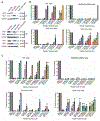Peptides from human BNIP5 and PXT1 and non-native binders of pro-apoptotic BAK can directly activate or inhibit BAK-mediated membrane permeabilization
- PMID: 36706751
- PMCID: PMC9992319
- DOI: 10.1016/j.str.2023.01.001
Peptides from human BNIP5 and PXT1 and non-native binders of pro-apoptotic BAK can directly activate or inhibit BAK-mediated membrane permeabilization
Abstract
Apoptosis is important for development and tissue homeostasis, and its dysregulation can lead to diseases, including cancer. As an apoptotic effector, BAK undergoes conformational changes that promote mitochondrial outer membrane disruption, leading to cell death. This is termed "activation" and can be induced by peptides from the human proteins BID, BIM, and PUMA. To identify additional peptides that can regulate BAK, we used computational protein design, yeast surface display screening, and structure-based energy scoring to identify 10 diverse new binders. We discovered peptides from the human proteins BNIP5 and PXT1 and three non-native peptides that activate BAK in liposome assays and induce cytochrome c release from mitochondria. Crystal structures and binding studies reveal a high degree of similarity among peptide activators and inhibitors, ruling out a simple function-determining property. Our results shed light on the vast peptide sequence space that can regulate BAK function and will guide the design of BAK-modulating tools and therapeutics.
Keywords: BAK activation; BAK inhibitor; BH3 peptides; BH3 profiling; apoptosis; binding kinetics; peptide design.
Copyright © 2023 Elsevier Ltd. All rights reserved.
Conflict of interest statement
Declaration of interests The authors declare no competing interests.
Figures









Similar articles
-
BH3 domains other than Bim and Bid can directly activate Bax/Bak.J Biol Chem. 2011 Jan 7;286(1):491-501. doi: 10.1074/jbc.M110.167148. Epub 2010 Nov 1. J Biol Chem. 2011. PMID: 21041309 Free PMC article.
-
The BH3 alpha-helical mimic BH3-M6 disrupts Bcl-X(L), Bcl-2, and MCL-1 protein-protein interactions with Bax, Bak, Bad, or Bim and induces apoptosis in a Bax- and Bim-dependent manner.J Biol Chem. 2011 Mar 18;286(11):9382-92. doi: 10.1074/jbc.M110.203638. Epub 2010 Dec 9. J Biol Chem. 2011. PMID: 21148306 Free PMC article.
-
Crystal structure of Bak bound to the BH3 domain of Bnip5, a noncanonical BH3 domain-containing protein.Proteins. 2024 Jan;92(1):44-51. doi: 10.1002/prot.26568. Epub 2023 Aug 8. Proteins. 2024. PMID: 37553948
-
Structural biology of the Bcl-2 family of proteins.Biochim Biophys Acta. 2004 Mar 1;1644(2-3):83-94. doi: 10.1016/j.bbamcr.2003.08.012. Biochim Biophys Acta. 2004. PMID: 14996493 Review.
-
Pro-apoptotic complexes of BAX and BAK on the outer mitochondrial membrane.Biochim Biophys Acta Mol Cell Res. 2022 Oct;1869(10):119317. doi: 10.1016/j.bbamcr.2022.119317. Epub 2022 Jun 22. Biochim Biophys Acta Mol Cell Res. 2022. PMID: 35752202 Review.
Cited by
-
Mechanisms of BCL-2 family proteins in mitochondrial apoptosis.Nat Rev Mol Cell Biol. 2023 Oct;24(10):732-748. doi: 10.1038/s41580-023-00629-4. Epub 2023 Jul 12. Nat Rev Mol Cell Biol. 2023. PMID: 37438560 Review.
-
Structural basis for proapoptotic activation of Bak by the noncanonical BH3-only protein Pxt1.PLoS Biol. 2023 Jun 14;21(6):e3002156. doi: 10.1371/journal.pbio.3002156. eCollection 2023 Jun. PLoS Biol. 2023. PMID: 37315086 Free PMC article.
-
Inhibition of BAK-mediated apoptosis by the BH3-only protein BNIP5.Cell Death Differ. 2025 Feb;32(2):320-336. doi: 10.1038/s41418-024-01386-3. Epub 2024 Oct 15. Cell Death Differ. 2025. PMID: 39406920
-
Deep learning molecular interaction motifs from receptor structures alone.J Cheminform. 2025 Jul 30;17(1):113. doi: 10.1186/s13321-025-01055-8. J Cheminform. 2025. PMID: 40739522 Free PMC article.
References
-
- Lindsten T, Ross AJ, King A, Zong W-X, Rathmell JC, Shiels HA, Ulrich E, Waymire KG, Mahar P, Frauwirth K, et al. (2000). The Combined Functions of Proapoptotic Bcl-2 Family Members Bak and Bax Are Essential for Normal Development of Multiple Tissues. Mol Cell 6, 1389–1399. 10.1016/s1097-2765(00)00136-2. - DOI - PMC - PubMed
Publication types
MeSH terms
Substances
Grants and funding
LinkOut - more resources
Full Text Sources
Research Materials

